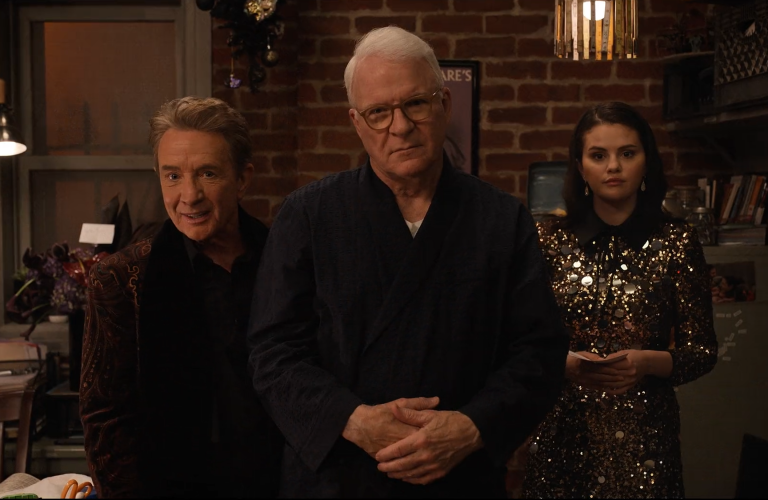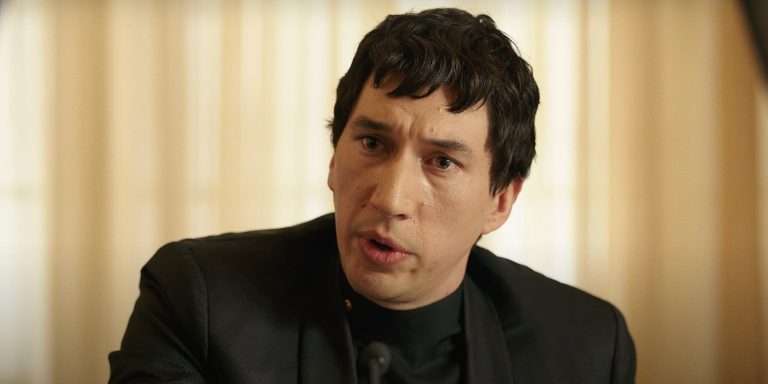Shin Godzilla (2016) Movie Ending Explained: In 1954, Japanese filmmaker Ishiro Honda directed and co-wrote the monster horror spectacle Godzilla (the word ‘Gojira’ is a combination of Japanese words for ‘gorilla’ and ‘whale’). Produced and released by Toho, the film initiated one of the longest franchises in cinematic history (Toho has made 33 Godzilla films so far). Although monster creature flicks were made in Hollywood (King Kong, The Beast from 20,000 Fathoms) before the 1954 Godzilla movie, the ‘Kaiju’ (‘strange beast’ in Japanese) subgenre was codified with the Godzilla franchise. Over the years, the giant reptilian monster has instigated fascinating permutations in Hollywood, including Pacific Rim and the MonsterVerse franchise.
In its home country, Godzilla was resurrected in a brilliant fashion with Shinji Higuchi & Hideaki Anno’s Shin Godzilla (2016 – Godzilla Resurgence in the US). It was apparent that the original Godzilla was an allegory about post-war Japan’s experience with nuclear horror. The film had direct visual references to the Hiroshima and Nagasaki atomic bombings and Tokyo fire bombings. Godzilla is the symbol of destruction, called upon the formerly militaristic island nation. Of course, when Hollywood adopted the distinctly Japanese monster for its 1998 movie, it stripped the political metaphor from the monster in favor of foolish, family-friendly thrills.
Recommended Read: Ringu (1998) Movie Ending & Themes Explained
In 2011, the Tohoku earthquake and tsunami caused the death of nearly 20,000 Japanese. However, it was the nuclear accident in the Fukushima Daiichi nuclear power plant that reawakened the traumatic memories of atomic bombings and created fear among the Japanese. Such pervasive feelings of dread were the basis of Hideaki Anno’s script for Shin Godzilla (‘shin’ has various meanings – in this context, it can mean ‘new’). Moreover, the 2016 reboot effectively satirizes the bureaucratic red tape surrounding disaster management and also explores Japan’s complex relationship with its closest ally, America. Now, let’s unpack the narrative details of this first Godzilla movie from the Reiwa era.
Spoilers Ahead!
Shin Godzilla (2016) Plot Explained:
What Causes the Undersea Thermal Discharge In Tokyo Bay?
Unlike the previous versions of Godzilla, the monster in Anno & Higuchi’s film is shown as a mutated and rapidly evolving creature. However, like in the original, it was created due to human errors, in this case, the dumping of nuclear waste in Tokyo Bay. The monster is said to be an unknown ancient marine organism that adapted itself to utilize atomic waste as a food source. Hence, apart from wreaking havoc with its monstrous gait, a Godzilla also happens to be a walking nuclear reactor.
Shin Godzilla opens with the Japanese Coast Guard spotting an abandoned yacht named ‘Glory-Maru’ in Tokyo Bay. Shortly after, there’s a sudden burst of steam, causing an accident at the Aqua-Line tunnel bridge, which is flooded. A disaster task force is set up to rescue the people in the area, particularly the ones trapped in the tunnel. Viral videos of the incident flood the online community. Deputy Chief Cabinet Secretary Rando Yaguchi (Hiro Hasegawa) watches one of the videos and spots a large creature of sorts in the Bay.
An emergency meeting is called for at the PM’s (Ren Osugi) office, where initially, it’s speculated that the undersea thermal discharge might be the result of a volcanic eruption or an unidentified hydrothermal vent. But the various ministers and aides argue over the scientific impossibility of such happenings. At this point, Yaguchi brings up his theory that it’s a colossal creature emerging from the sea floor. He cites the online footage, but we live in an era where online footage isn’t taken as conclusive evidence. Moreover, the top brass wonders what kind of creature has a temperature over 100 degrees.
Can the Monstrous Creature Come Ashore?
Yaguchi’s concerns are dismissed, and they decide to consider it a volcanic activity. But at the disaster response council meeting, the bureaucrats are stunned to see a news report showing the enormous tail of a creature. Now. Yaguchi’s theory becomes a palpable reality. Nevertheless, the administrators are preoccupied with damage control and discuss how to present it to the media and the public. Before knowing what type of creature they are dealing with, the cabinet calls for extermination. The talks exemplify the impersonality of bureaucracy as the logistics are the primary concern. Can the Self-Defense Force (SDF) use weapons to conduct such an operation in Tokyo Bay? Will it be a problem if they use torpedoes, or should they capture it alive?
A trail of vapor clouds follows the creature as the nearby shores get flooded. Three environmentalists arrive in the PM’s office, who are more worried about their credibility and show zero curiosity about the creature’s identity. However, outside the calm office atmosphere, the unknown creature steadily moves toward land, causing death and destruction. Deputy Chief of Environmental Ministry, Hiromi Ogashira (Mikako Ichikawa) is called in. From the footage, she sees the creature has gills, like aquatic species, but has relatively smaller legs. There’s a question over whether the creature can reach the land. To which a decorous expert says it’s physiologically impossible for it to reach the land.
The Mishandling of the Situation Persists
The visuals of the creature moving through the river by pushing heaps of boats and cars are a direct reference to the 2011 Tohoku earthquake and tsunami. The Prime Minister starts reassuring the public at the press conference before gathering proper intel on the creature. But just as he says the creature won’t come ashore, there’s footage of the creature with large googly eyes slithering like a reptile in the crowded streets. The creature’s hind legs are well-developed, but the arms are underdeveloped.
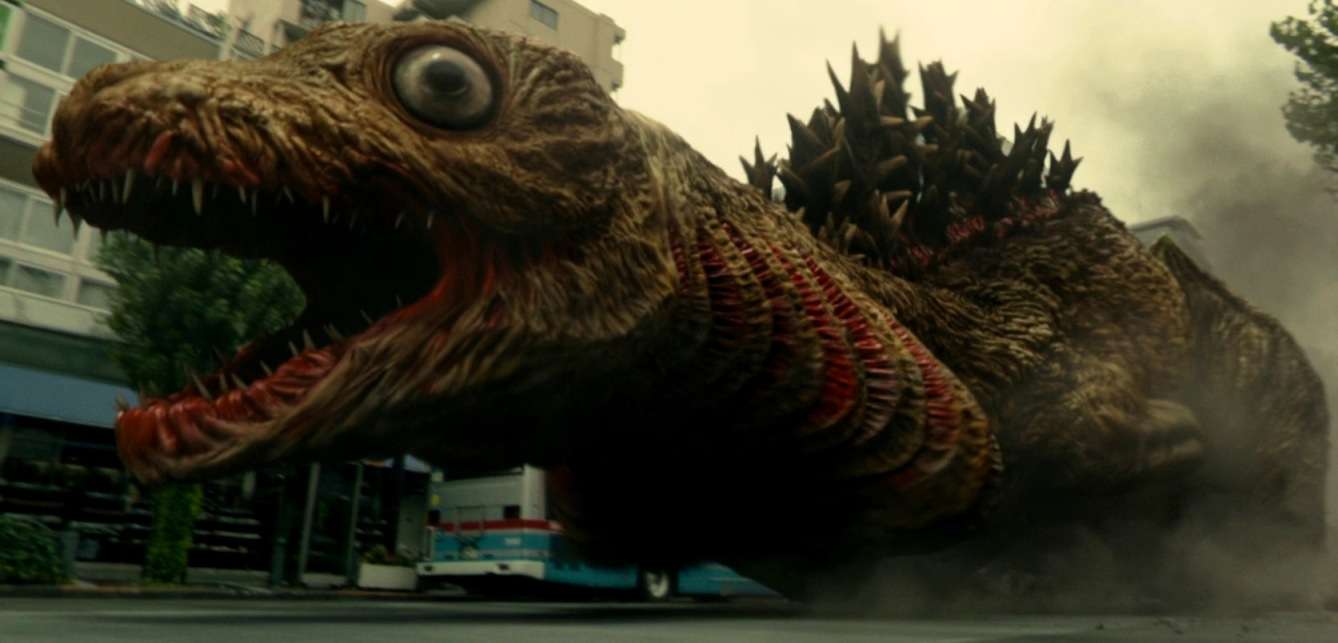
While we don’t get a clear look at the creature’s first form, its shark-like gills are bleeding a blood-like substance in the second form. The Cabinet Council initiates city-wide evacuation measures in the area. However, on the question of how to deal with the beast, there’s still uncertainty. Should they mobilize the police or defense forces? How to face the collateral damage? Can the US help them under the Security Treaty, and so on. Eventually, SDF is mobilized to exterminate the creature.
How Does the Creature Look in its Third Form?
Meanwhile, the creature stops its progression. It begins to evolve into its third form by standing upright and growing larger arms. While the eyes are still unfocused, the dorsal fins transform into a spine. Due to heat generation, its spine, i.e., dorsal fins, lights up. The creature now comes close to the original Godzilla design. Yet, it looks disoriented and seems to be in pain. Soon, the military helicopters arrive to open fire. But before facing the attack, the monster returns to the sea. A semblance of normalcy is restored in Tokyo in the following days. The government surveils and patrols for any glimpse of the creature.
Who Is Goro Maki?
A special task force is formed, and Yaguchi is named the bureau chief. A group of bureaucrats unafraid of speaking their minds to the PM – including Ogashira – are chosen for the task force. When there’s news of high radiation readings in the creature’s path, Ogashira guesses that the monster energizes itself through nuclear fission. Subsequently, the US sends Japanese-American Kayoco Anne Patterson (Satomi Ishihara) as a special envoy to meet Yaguchi. She shares information on Goro Maki, a zoology professor who worked at a US energy firm. Kayoco says Goro Maki foresaw the creature’s appearance on the Japanese shores.
The Japanese intelligence network’s report states that Maki is missing, and the Japanese coast guard found his boat. It’s the yacht, ‘Glory-Maru,’ we see in the opening scene. They have, however, retrieved his research notes, which is what America primarily seeks. On behalf of the US, Kayoco shares their report on the creature named ‘Godzilla.’ Goro Maki has used the Japanese name ‘Gojira.’ On Odo island, it means “God’s Incarnate” (Odo is the fictitious island, which is where the creature comes ashore in the 1954 original film).
US and Japanese scientists widely disbelieved Goro Maki’s theory about a primordial deep sea organism rapidly mutating after feeding nuclear waste. His decades-long research on the creature is presented in the form of an encoded data sheet. And his research has been under the radar of the US Department of Energy. However, the task force members can’t immediately make sense of Maki’s molecular analysis.
How Can They Stop Godzilla’s Rampage?
When the task force members wonder why Godzilla returned to the sea, they zero in on its nuclear reactor-like biology. Furthermore, they conclude that it has a blood-cooling system that needs an abundance of water. Going by this logic, Ogashira suggests rapidly cooling its internal system. Of course, this could only immobilize the monster, not kill it. The method calls for administering blood-coagulating drugs. Yaguchi discusses with SDF to find practical methods to enact the plan. It is unofficially known as the ‘Yaguchi Plan.’
Godzilla is eventually cited near Kamakura (south of Tokyo). The monster has evolved to the classic Godzilla design – fourth form – where its arms and heads are more developed and look more muscular. The long tail with its spiky fins and the unhinged looks make it seem like the monster is coming ashore with the intent to annihilate. Since the ‘Yaguchi Plan’ is not yet ready, the Prime Minister gives SDF the order to attack. The SDF is to do whatever it takes to stop Godzilla from entering Tokyo or attacking any nuclear facility on its way.
Is Godzilla Invincible?
Keeping Tama River as the defense line, attack helicopters, and tanks rush to the battleground. But the machine gun fire and missiles prove to be ineffective. Godzilla easily crosses the river and marches toward Tokyo. The power is down in the city, and Godzilla’s body emits a red glow. People panic and run to the underground as the American Air Force sends their fleet of bombers. Since the PM’s Office is also in the monster’s path, the Prime Minister is convinced to leave the facility by a chopper.
Soon, the US bombers strike Godzilla, and it howls in pain as the bombs pierce its skin and it bleeds. But to everyone’s surprise, Godzilla’s dorsal fins start emitting a purple glow. The monster first opens its mouth, venting out black smoke, and then produces a fireball that burns up a large section of the city. Subsequently, the fireball contracts to become a thin, sharp pink laser light that cuts down buildings. Godzilla’s dorsal fins also start projecting the purple heat ray, obliterating the US bombers and the Japanese PM’s chopper. As the ruins of Tokyo are consumed by fire, the purple glow gradually fades, and Godzilla goes dormant.
What’s the US Plan to Destroy Godzilla?
The Agriculture Minister is appointed as the acting PM, and Yaguchi’s team works full-time to initiate their blood-coagulation plan. Meanwhile, a reconnaissance team in the Tokyo ruins finds one of Godzilla’s severed dorsal fins, which is regenerating on its own and can become a separate functioning organism. The monster’s asexual reproduction scares the experts further since, at this rate, it can spread all over Tokyo and then Japan. Moreover, considering the monster’s evolutionary capacities, at some point, it can sprout wings and fly to a different continent.
Yaguchi meets Kayoco, who informs him that the White House and Pentagon are in support of dropping an atomic bomb on Tokyo. Kayoco herself was ordered to evacuate. Hence, it’s highly likely that through official channels, America might pressure the Japanese government to accept their decision. The US definitely doesn’t want China and Russia to find their way into the Godzilla crisis management. The UN Security Council will naturally follow the US guidance. Yaguchi and Kayoco lament about the possible third atomic bomb attack on Japan.
Shin Godzilla (2016) Movie Ending Explained:
How Do the Experts Decipher Maki’s Molecular Analysis?
Yaguchi speaks with the Chief Cabinet Secretary, Hideki Akasaka (Yukata Takenouchi), about the freezing plan. Akasaka says Yaguchi’s idea contains too many uncertainties. If they can’t immobilize the creature for sure, then Japan might lose its trust among the world nations. Once again, like the post-war humiliation, Japan might have to put itself under the UN’s hands. Though evacuating more than three million Tokyo residents will be a great challenge before the two-week window of a nuclear strike, Akasaka states at least all countries have pledged their support for the rebuilding effort. Beyond the two-week time frame, the dormant Godzilla might resume its activity.
The task force headed by Yaguchi is yet to synthesize a coagulant that can immobilize Godzilla. Moreover, the chief issue is that they are yet to decipher the molecular data left by Goro Maki. At one point, a task force member wonders why Maki put the data on a paper sheet. Another says perhaps it’s meant to be folded. The sparks fly. Yes, the answer is Origami. By folding the sheet, they can perceive how Godzilla’s cells metabolize radiation. It doesn’t directly feed on nuclear waste but simply metabolizes radiation in the presence of oxygen and water. They also run the data analysis on a German Supercomputer to ensure the blood coagulant plan is viable on Godzilla’s body. Now, the task force improvises its plan based on the solved data and fast-track the process to procure the coagulants.
What’s Operation Yashiori?
Yaguchi gets the approval from the interim PM and meets the Chief of Staff to flesh out the plan, who also gives the operation its name: “Operation Yashiori.” Kayoco puts her political career at risk and promises the support of the US drones for the operation. On the day of Operation Yashiori, they first send trains loaded with explosives to ram into Godzilla’s legs, reawakening the monster. Then, the aerial assault begins with the uncrewed US drones. But Godzilla destroys the drones using its dorsal fin heat rays. The idea is to make Godzilla expend its atomic energy. Once it discharges its energy, the skyscrapers around Godzilla are blasted to pin it down.
As the monster lies on the ground, the trucks full of coagulants head towards it. The coagulants are injected into Godzilla’s mouth using long, extended tubes. Suddenly, Godzilla stirs, stands upright, and sends a thin atomic beam, destroying the trucks lined up close to it. Now, more trains filled with explosives are sent again to pin down the monster. The second and third waves of trucks rush to the spot to pump the coagulant further in order to reach optimal levels. Upon reaching a critical point, Godzilla’s skin starts stiffening. Nevertheless, it stands up, emitting a feeble purple glow, and starts roaring but soon freezes solid (-196 degrees Celsius, says the reading).
The Uncertain Fate of the World
After the operation’s success, the experts in the task force discover that the half-life of Godzilla’s radiation is just twenty days. This means Tokyo can recover from the nuclear fallout in a very few years. Kayoco meets Yaguchi on a rooftop, and the frozen Godzilla is visible in the distance. She says Yaguchi has merely postponed the inevitable since America will be ready with a thermonuclear attack once Godzilla starts moving. Yaguchi expresses hope and has shared the data with the rest of the world, which might, in the near future, lead to a solution not involving a nuclear strike. “Now’s not the time to quit. Things are far from settled” – Yaguchi’s final words strongly resonate with us as we live in a world that’s foreseeing devastating environmental disasters in the upcoming decades.
What Are Those Skeletal Humanoid Things?
Shin Godzilla (2016) leaves us with an eerie final shot of the monster’s tail tip. On the frozen tail, we see many skeletal humanoids with dorsal fins. These look a bit like the Xenomorphs in the Alien franchise. The humanoid forms could be people fused to its spiky tail during its rampage. But going by the film’s hypothesis on Godzilla’s asexual reproduction and its limitless evolutionary capabilities, the shot of the tail could be key to the monster’s next phase of evolution. There are theories stating that humanoid creatures are Godzilla’s new form to overcome the human community – dubbed as Godzilla’s fifth form. Is Godzilla creating a hive community to make these humanoid things do its bidding?
The little humanoid monsters are the makers’ way of teasing for a sequel and fueling speculation. Unfortunately, there are no plans for a direct sequel to Shin Godzilla (officially announced in 2018). Hence, there might not be any exciting follow-up to this terrifying final shot of Godzilla’s tail tip.




![Oslo August 31st [2011] MUBI Review – A sympathetic tale of a drug-addict coming to terms with his life](https://79468c92.delivery.rocketcdn.me/wp-content/uploads/2017/04/review-oslo-august-31st-joachim-trier-768x415.jpg)
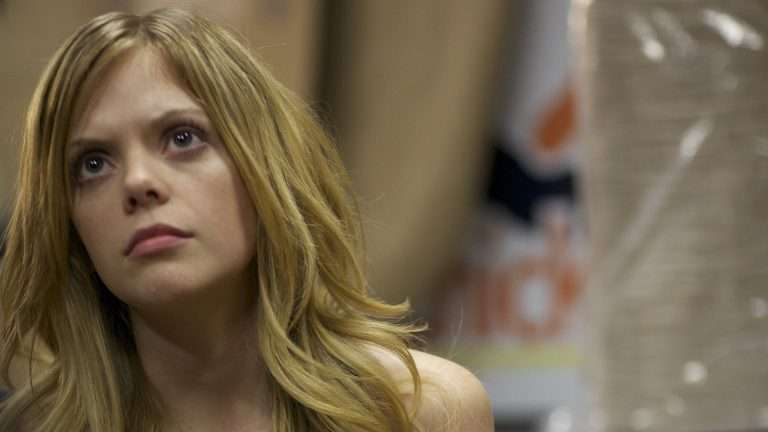
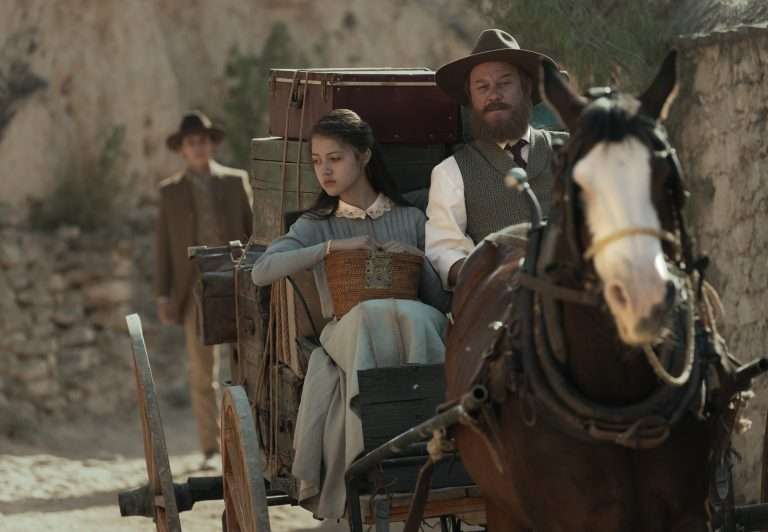
![Taxi [2015]: An Awe-Inspiring Iranian Minimalist Cinema](https://79468c92.delivery.rocketcdn.me/wp-content/uploads/2016/01/201511112_5.jpg)
